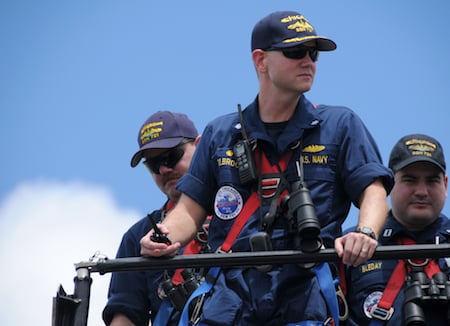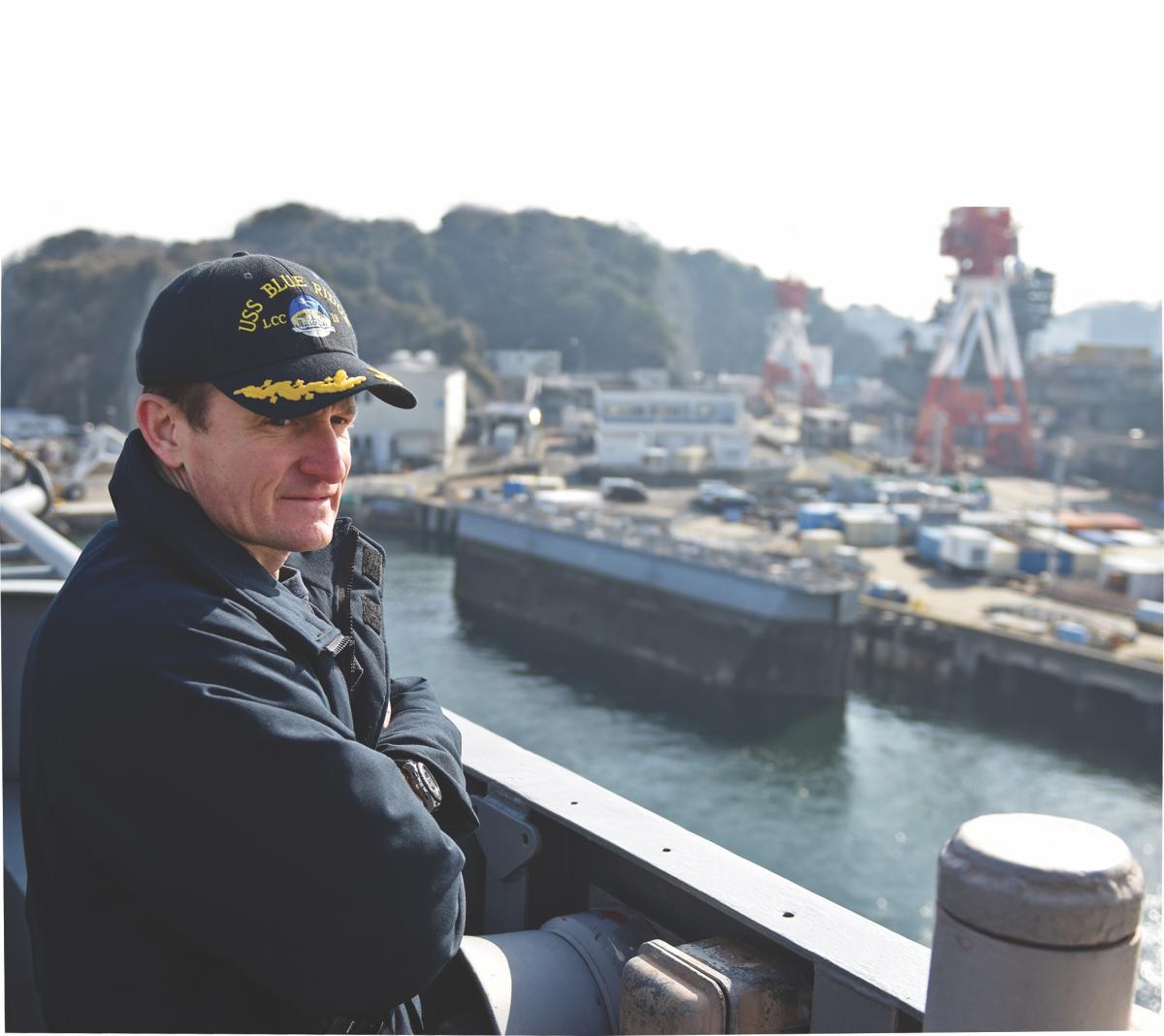Draft language in the 2019 National Defense Authorization Act (NDAA) calling for bifurcation of the surface warfare career path created quite a stir among surface warfare officers (SWOs) and Navy pundits. The House version of the NDAA proposed directing the Navy to “establish two career paths for surface warfare officers. . . . one career path in ship engineering systems and another in ship operations and combat systems, not later than January 1, 2021.”1 That provision was removed in conference and replaced with direction for a Government Accountability Office (GAO) study of SWO career paths to be completed by 1 March 2019.2
The cited impetus for these changes was the deadly 2017 collisions involving the USS Fitzgerald (DDG-62) and John S. McCain (DDG-56). But before implementing reactionary changes, it is essential to understand how the surface community arrived at its current generalist format and examine how the various line communities adapted to ensure proficiency within the generalist path. With this understanding, the Navy’s surface warfare community can adjust its officer career path, with or without congressional action, enabling a focus on both tactical and technical proficiency.
A Tale as Old as Steam
In the Age of Sail, line officers held primacy within the Navy. Seamanship dominated the Navy’s ability to wage war, and line officers were seamen first and foremost. Naval constructors, the engineers of their day, existed within the staff corps and primarily supported the service ashore. The 1836 introduction of steam propulsion, however, created the fulcrum on which the nearly two-centuries-long debate on engineering and deck career paths turns.
In 1842, the Navy formed the engineer corps to manage the ever-growing number of steam propulsion systems in the fleet. These officers initially served without rank—holding only the title of “engineer”—but they soon began playing a significant role in maneuvering the ship and thus directly influencing the ship’s war-fighting ability. This integral shipboard function put engineers in direct competition with line officers over control of the Navy’s future. As increasingly complex naval vessels joined the fleet, engineer officers gained greater influence over warfighting capability, but they remained inferior in rank and pay to their line officer counterparts.
The debate over primacy between engineers and line officers raged in naval circles and public forums, with both sides lobbying Congress to legislate their objectives. Throughout the late 1890s, the Navy and Congress dedicated significant effort to organizing the officer corps for the industrial-age Navy, but the service struggled to reach consensus on the relative role of line and engineer officers. The 55th Congress ended the debate by directing amalgamation of the line and engineer officer corps in 1899.3
With amalgamation, the study of engineering within the line officer corps increased dramatically. While the U.S. Naval Academy began training engineer cadets as early as 1864, its primary focus remained seamanship. After 1899, the Academy expanded its curriculum to focus on the engineering aspects of naval warfare, culminating in all Naval Academy graduates today receiving a bachelor of science degree regardless of their field of study.4 This engineering emphasis also exists in the Naval Reserve Officer Training Corps, with approximately 80 percent of its graduates now earning technical degrees.5 Thus, throughout the 20th century, line officers trained in both the technical and tactical aspects of ship operations, and some would even say with too much emphasis on engineering.6

Recognizing that engineering specialization remained necessary for the design, construction, maintenance, repair, and overhaul of naval vessels, the Navy retained some engineers for engineering duty only. Later designated as engineering duty officers (EDOs), this relatively small group of officers is part of the restricted line. This designation separates them from the staff corps but also restricts their opportunity to command ships. While EDOs can go to sea, especially in large vessels with expansive engineering departments, they focus primarily on the shore establishment.7
Aviation, Submarines Challenge the Line
At the turn of the 20th century, all line officers were surface officers as all but a few naval vessels were surface ships. Naval aviation and submarines expanded line officer career options, but at their core, all line officers remained surface officers into the interwar period. Aviators and submariners began their naval service on board surface ships and moved back and forth during their careers.
(U.S. Navy/Steve Zurell)
Naval aviators were the first line officer specialty to recognize the need for proficiency that challenged the traditional dominance of the surface line. They received support from Congress in 1921 with a law directing “that flying units or detachments, with the exception of aircraft carriers or other vessels, shall in all cases be commanded by flying officers.”8 As early as 1924, Commander Kenneth Whiting urged training naval aviators immediately upon graduation from the Naval Academy in lieu of an initial shipboard tour. Aviators then would progress in aviation billets in parallel with their surface line counterparts. But non-aviators, who by and large were senior to most aviators, believed seamanship and at-sea experience were necessary to command maritime aviation.9
Similar to the engineer-line debate of the 1890s, this fight ended up in Congress. Naval aviators, led by Rear Admiral William A. Moffett, convinced their friends in Congress that all naval aviation units, including aircraft carriers, should be commanded by aviators. In 1926, Congress amended the aviation command eligibility law, directing that aircraft carriers be commanded by a naval aviator, a statute that remains to this day.10 This addressed the aviators’ two principal concerns: command of aviation units by experts in the field and command opportunities required for promotion to senior ranks.
Since the 1920s, naval aviation has fine-tuned its career path with the goal of delivering highly capable officers to command aviation squadrons, air groups, airfields, and aircraft carriers. By the height of the Cold War, the community arrived at “type-model-series” specialization, under which aviators select a specific aircraft at the end of flight school and remain in that type, model, and series for their careers. This allows them to maintain the tactical and technical proficiency necessary to operate, and eventually command, these sophisticated war machines.
With the introduction of nuclear propulsion in the 1950s, Admiral Hyman G. Rickover chose line officers to train intensively in the engineering aspects of nuclear power. EDOs, such as Rickover himself, played a significant role in the design and maintenance of nuclear-powered vessels, but technically trained line officers were counted on to employ them.11 Rickover did this without direct congressional action, but instead through naval directives under the authority given to the Director of Naval Reactors by Congress.12
The submariner career path evolved over the years such that all submarine officers train and qualify in nuclear power, regardless of their shipboard duties. Thus, while submarine officers split their time between engineering and ship’s operations, they all have a foundation of engineering training and an appreciation for the technical aspects of submarine operation.
The submarine community balances the need for technical and tactical proficiency through careful officer billet management. Some submariners serve and gain proficiency in tactical billets in weapons and operations, while others accrue additional expertise on the propulsion plant. To ensure submarines are best prepared to fight and meet the demanding standards of nuclear power, the community carefully assigns executive officer/commanding officer teams so that one officer has served as a submarine engineer officer and the other has advanced experience in ship’s operations. This career path was developed internal to the community and is managed within the bounds of congressionally mandated officer career milestones.

While submarine officers split their time between engineering and ship’s operations, they all have a foundation in engineering and an appreciation for the technical aspects of submarine operation. (U.S. Navy/Jeffrey Jay)
The Royal Navy Model
In addition to examining current and historical U.S. surface warfare career paths, the NDAA directs the GAO to assess those of foreign navies. One model is the Royal Navy, which faced the same concerns about line and engineering officers as the U.S. Navy with the introduction of steam propulsion but chose the opposite path.
The Royal Navy divided its officer corps between line officers (now referred to as primary warfare officers [PWOs]) and engineers. Engineers today are further divided into marine and weapon specializations and are responsible for maintaining the material readiness of ships’ systems. Only PWOs can advance to command, but the relative ranks of engineers and PWOs are the same, and the chief engineer on board ship is second only to the captain in responsibility.13
Options for Future SWOs
The solutions used by the aviation and submarine communities and the Royal Navy to maintain tactical and technical proficiency offer options for the Navy to consider in addressing systemic concerns in the surface line officer community. While each approach would address concerns highlighted by recent seamanship mishaps, they come with trade-offs:
• Bifurcating engineering and deck into separate career paths—the Royal Navy model and the solution proposed by the House—would allow each branch to focus on either the technical or the tactical aspects of ship operation. But this option would be highly disruptive, requiring segregation of the current surface line community and a significant adjustment to officer personnel management.14
• The aviation type-model-series approach could be implemented by freezing officers in their current ship classes and adjusting detailing to return them to the same classes for subsequent tours. This would allow officers to become intimately familiar with all aspects of a given ship class, serving up to four separate tours in the class before ascending to command. Challenges here include lack of uniformity across ship classes, disparities in ship sizes, and the need for officers to support at-sea billets outside traditional surface combatants, which might interrupt career timing and disadvantage some officers. Aviation has dealt successfully with similar challenges, so these should not be insurmountable.
• While making all SWOs engineers as in the submarine model is not feasible—the large number of SWOs and the limited number of engineering jobs on board ship preclude giving all officers an opportunity to serve in engineering billets—a modification could allow junior officers to specialize in engineering or combat systems for their division officer and department head tours. Following the submarine model, selecting one officer from each of these paths for the executive officer and commanding officer billets would ensure the two senior officers possess a combination of engineering and topside experience. This would not achieve the same level of tactical or technical proficiency as bifurcation, but it could be done with much less disruption to the existing career path and promotion timing. It also is flexible enough to allow for a broad range of qualifying billets across surface warfare.
• Maintaining the status quo would focus on working within the current system to address areas of concern identified in the “Strategic Readiness Review” and “Comprehensive Review of Recent Surface Force Incidents.” This would include improved pipeline and refresher training, supervision of qualification processes, independent assessment, and SWO logbooks. This option is least disruptive but may not satisfy the desire for change.
Ensuring Proficiency
While the tragic death of 17 sailors demands change, the objective of that change must be ensuring the technical and tactical proficiency of SWOs. Without that objective at the fore, change will merely satisfy the desire to “do something” rather than achieve a lasting effect. The Navy must fully explore each option and, in cooperation with the GAO, present advantages and disadvantages so that if Congress feels it must act, it will do so in a manner that will improve the surface Navy’s technical and tactical proficiency.
1. 115th Congress, 2d Session, National Defense Authorization Act for Fiscal Year 2019, H.R. 5515, House Reported Bill, Section 502.
2. 115th Congress, 2d Session, John S. McCain National Defense Authorization Act for Fiscal Year 2019, H.R. 5515, Enrolled Bill, Section 514, 19 June 2018.
3. Donald Chisholm, Waiting for Dead Men’s Shoes: Origins and Development of the U.S. Navy’s Officer Personnel System, 1793–1941 (Stanford, CA: Stanford University Press, 2001), 420, 430−33, 461−64.
4. For an interesting treatise on the current trajectory of naval officer education, see CAPT William R. Bray, USN, “The Well-Educated Officer,” U.S. Naval Institute Proceedings 142, no. 1 (January 2016).
5. John F. Lehman, Command of the Seas (Annapolis, MD: Naval Institute Press, 2001), 25−26.
6. Michael Junge, Crimes of Command in the United States Navy 1945–2015 (Jamestown, RI, Nauta Press, 2018), 195−96.
7. Chisholm, Waiting for Dead Men’s Shoes, 453, 464.
8. Act of 12 July 1921, ch. 44 (34 U.S.C. 734) §8.
9. Chisholm, Waiting for Dead Men’s Shoes, 643.
10. 10 USC 551 §5942, Aviation Commands: eligibility.
11. Dave Oliver, Against the Tide: Rickover’s Leadership Principles and the Rise of the Nuclear Navy (Annapolis, MD: Naval Institute Press, 2014), 11−19.
12. 68 Stat. 919, The Atomic Energy Act of 1954. The current authority of Naval Reactors derives from Presidential Executive Order 12344, 42 U.S.C. Sec 7158, Public Law 98-525 and 50 U.S.C. Sec. 2406, Public Law 106-65.
13. Royal Navy official website, Surface Warfare page.
14. Bryan McGrath, “Back Off, Congress: Don’t Meddle with the U.S. Navy’s Command Philosophy,” Defense One, 23 March 2018.



